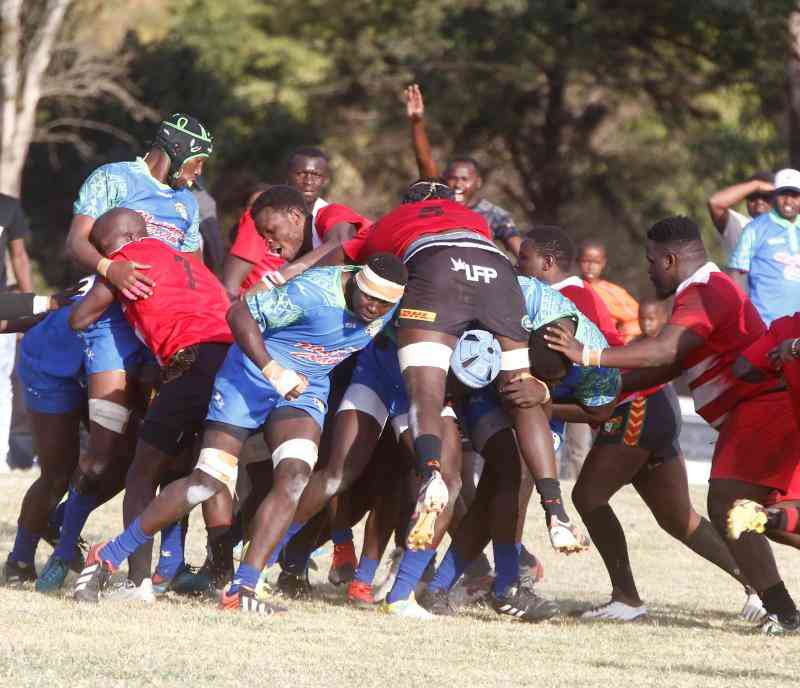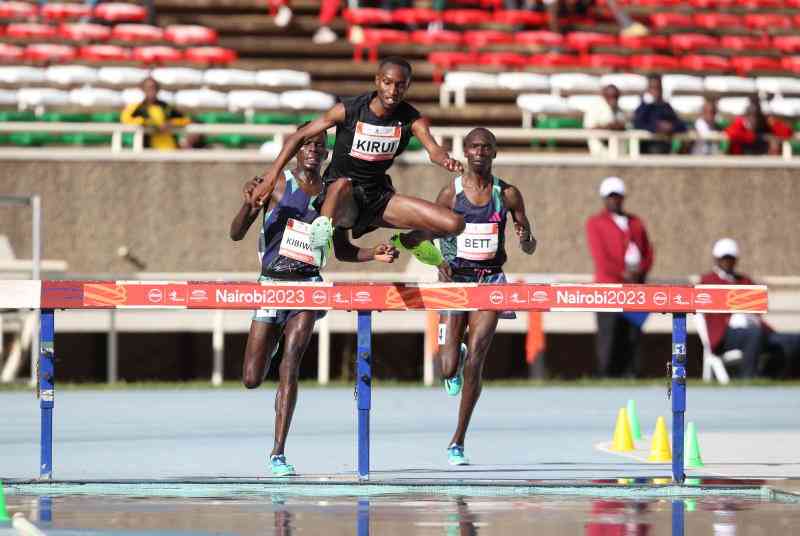
The caddie needs to know his pro’s golf clubs and equipment and ensure it is always in good condition.
To most weekend warriors, a caddie is that young man who carries or drags your golf bag around the course and searches for your golf ball after you hit it into the bundus at the risk of meeting some reptiles of the slithery kind.
He gets his feet and clothes wet as he retrieves your old beaten up ball that would at best be a range ball, from the water hazard and at the end of the round washes your golf clubs. He may also give you some playing tips on the course.
Some new golfers even trust the caddie to teach them golf, which is a huge mistake. For regular caddie services, a stipulated caddie fee, currently around Sh1,000 in the Nairobi area, is paid.
A tip is usually added as a sign of appreciation if the client golfer feels that the caddie did an exceptional job or performed above his regular call of duty. Read that as, “found all my errant balls in the bush”.
Some caddies engage in illegal activities like the caddie using his Footwedge to assist the golfer escape the bush. Some cut a hole in their trouser pocket down which they secretly drop a second ball if the one in play is lost, to earn a bigger tip. They must have learnt that from Goldfinger. Do note the word Illegal.
It therefore comes out as a huge surprise to hear that one caddie at the Kenya Open this year, might take home a million shillings without hitting a single ball. One Njiraini from KRA is bound to take away some as Caesar’s dues, but that is not the point.
The issue is that it is a huge cheque for someone who has probably never held Sh10, 000 in his pocket, or seen Sh100, 000 in one chunk. Except when he carried a cool half a million in bank notes for a quartet of golf-crazy gambling golfers from Kiambu, if at all those stories of insane gambling that are the bane of Kenya’s golfing folklore are true.
A caddie for a professional golfer typically earns 5 percent to 10 percent of the players’ winnings, on top of any salary he’s paid.
Forbes reports that PGA Tour Caddies typically receive about $1,000 (Sh100,000) each week. The magazine said in a 2007 article that Steve Williams, then caddeing for Tiger Woods, earned $1.27 million (Sh127m) in 2006.
Before you quit your day job and run to take up caddeing, you need to be aware of a few crucial facts. First, you need to know that just as there are amateur golfers and professional golfers, there are also loopers and professional caddies.
Loopers do what is described above: they offer very basic services to a golfer and earn minimal wages. In first world western countries, they don’t even exist: a regular club golfer handles his own bag, including carrying it and searching for his ball in the rough.
It is quite easy actually, and a very effective physical exercise, as this writer found out while golfing with that eclectic group of Kenyan golfers in the USA who go the name Safari Golf. In the East, basic caddeing is exclusive to ladies. In Japan it is not unusual for one lady to caddie for two golfers and not lose a single golf ball.
Professional caddeing on the other hand is a full time job, and a profession. The job is totally different from regular looping.
A pro caddie is a pro golfer’s right hand man, in the real meaning of the expression. The two work as a Team, chanda na pete. They will have developed an understanding of each other to enable clear communication, including nuances, doubts and fear.
Many pro caddies are good golfers who never made it on tour. They therefore know and understand golf as good as the golf pro himself. This is very important, especially when it comes to the rules of golf. A caddie can make a mistake that could cost the pro dearly.
Woosnam’s debacle
An oft-quoted incident happened in the final round of the 2001 British Open, where Welsh professional golfer Ian Woosnam was a favorite to win. Unfortunately, his Caddie forgot to remove an extra driver that Woosnam had been trying out at the range earlier from the bag.
On the tee of the second hole, his caddie told him, “Boss, you're going to go ballistic. We've got two drivers in the bag”. This coming after Woosnam had just tapped in for birdie on the opening hole and was just one shot behind the leaders.
Woosnam blew his top: “I give you one bloody job and you can’t even do that!”. “Give it to me!”He then yanked the offending driver and threw it away. For that fifteen clubs blunder, Woosnam was slapped with a two-shot penalty and never recovered.
He would have finished in second place and collected prize money of £360,000. Instead, he finished in a six-way tie for third place, collecting £141,667 in the process.
The lost £218,333 (Sh27m) prize money cost Woosnam a place on that year’s Ryder Cup team. He was actually lucky that it was discovered before he hit his tee shot, otherwise he would have suffered the maximum penalty of four shots. Closer home, golfers know that if your own ball hits your golf bag or your caddie, the result is a penalty stroke.
The other thing a caddie has to know is the courses he shall be competing on like the back of his hand. The caddie flies from his home to the next course they shall be competing out, anywhere in the world, a day or two ahead to do his due diligence investigations and research.
It is his duty to know each and every nook and cranny on that course, since the ball can go anywhere. Using a rangefinder, he checks the yardage books for accuracy and might have to prepare one from scratch, which involves mapping all the fairways, greens and bunkers. And not just distance, slopes and lies too.
Unusual features like false fronts, multi-tiered greens and false breaks, have to be identified and noted. He then works out how long those distances are actually playing especially for approach shots to the greens and carries over water hazards and bunkers. He evaluates different strategies to play every hole.
For each, he notes the best golf club, shot and shot shape combination that offers the pro the best payoff and least risk, and advises him.
Apart from being an advisor, the caddie’s role is also of psychologist, motivator and spiritual advisor. He has to know how to intervene if the pro’s spirits head south or he gets too eager, excited or angry for his own good. He has to fully know the golfer and monitor his condition throughout a round. Fatigue creeps in slowly and can flummox a golfer who is not aware. He has to be able to communicate with the golfer clearly and be well understood.
There is quite a bit of stuff in a pro golfer’s bag. A competition-ready golf bag will have in it a set of muscleback irons with heavy steel stiff or extra stiff shafts, driver, woods, hybrid clubs, a putter, three or four wedges, rangefinder, a couple of leather gloves, half a dozen golf balls, a rainsuit and a double-canopy umbrella.
It has to have two towels, swing donut, tees, sun block lotion, Elastoplast bands, a bottle of water, a snack and the bag itself. The Caddie has to be strong and fit enough to haul that 12 to 15 kilogram load through a typical eight-kilometre course, over a period of five hours, without sitting down for a single moment, mostly walking very fast or standing still like a sentry.
Needless to say, the caddie needs to know his pro’s golf clubs and equipment and ensure it is always in good condition. The lofts of forged steel Irons and wedges slowly change over time and hence need to be checked. Club grips get worn out and may have to be changed frequently.
They also get oily and slippery due to handling and have to be wiped after each round and washed often. Club grooves be cleaned after every shot and wire-brushed after every shot. Similarly, face towels and towels for wiping clubs have to be washed after every round.
Interestingly, caddies spend a lot of time watching golf tournaments either in person, on TV or on recorded media. Their main concern is to identify holes that play different from the expected or greens that break strangely.
For example, on some putts at the Gary Player course, host of the Nedbank Open, break in the opposite direction! Even the best golfers and caddie would not predict such wackiness, and hence rely on history from previous competitions. Augusta’s sleek bikini waxed greens are known for putts that have to be hit uphill and away from the hole, then the ball making a U-turn to the hole.
Bearing all these in mind, it is clear that a pro caddie’s job is not a walk in the park. Neither is it just lugging the bag and spotting balls that rarely go OB. There's an old bit of wisdom that says a good caddie will save his player one stroke per round, which is the equivalent of four strokes per tournament.
That alone will make a huge difference in the results. The good news is that these caddies are pretty well rewarded for their efforts. According to a 2003 article in the “Sydney Morning Herald,” the caddie’s standard cut of the Prize money at that time was 10 percent if the player won a PGA Tour event. Thus would be the equivalent to the winnings for the golfer who finishes in 12th position. Eight percent is paid to the caddie if the player finished in second through Tenth place, and about six percent for a golfer who makes the Cut. There is no share if the golfer does not make the cut, obviously, just the routine caddie fee, maybe a tip in recognition of extra effort.
How about at the Kenya Open? Before we discuss how much they should be paid, we need to ask if we have caddies of pro caliber; caddies who can perform all the functions discussed above. I think not.
In 2017, the caddies at the Kenya Open protested against pros from foreign countries bringing in their own caddies for the Kenya Open. Of course the local caddies would have loved to be the ones enjoying that share of the winnings.
But would they have worked for it or were the pros doing all the work? I suspect they may have been underrating the job, out ignorance of what a professional caddie is required to do. Since they are neither employees of, nor chanda na pete partners, with these foreigners, it is doubtful whether they can offer the complete package of services required.
At the Challenge Tour level, and other lower tours, not every pro golfer wants to spend money shipping his caddie to Kenya from Europe, the Americas and Asia, then pay for their hotel and food for week, if pro caddie services can be obtained locally.
Some foreign pros have complained about lack of professional caddies in Kenya. Language is also an issue. The Kenya Open attracts pros from all over the world. I have yet to come across one caddie who speaks French, Italian, Spanish, Swedish, and Dutch or even Afrikaans.
Not to deride our caddies but, what will he to communicate to the pro who expects to hear the tech loaded, “177 yards playing uphill 185, 12mph right-to-left tailwind, downhill flier lie. Ball will come out hot. Play 6 iron, 5meter draw, ride the wind, run it up right fringe, avoid right greenside bunker. Miss left not right, be short not long.”? Even if he had that analysis and information, it would be a tall order to translate it from Kiswahili to Swedish.
If it wasn’t for ego, the best caddie would probably be a Kenyan pro who missed the cut. And why not? There is a million shillings at stake.
Emma Löfgren, Henrick Stenson’s wife of twelve years and mother of his three children, caddies for him. So did Justine, Patrick Reeds wife; until she became expectant. When Chris Paisley won the South Africa Open this year, his wife, Keri, was on the bag.
In the absence of professional caddies, our resident caddies are stuck to earning just the traditional Sh5,000 for five days of looping, for “merely hauling the bag and spotting the ball”. The pro golfer has to do the rest for himself. Maybe when that KGU Golf School comes to fruition, caddeing lessons shall be provided and caddies certified for professional duties. Only these caddies would be allowed to caddie at the Kenya Open and other professional events, and only they would be justified in demanding for a cut of the pros’ earnings.
Our caddies do have some local knowledge that helps these pros. The pros are certainly not everything. It is therefore fitting that such caddies earn slightly more than they do for mere looping.
Who knows, the Kenya Open Winner may turn out to have done it with the help of a local caddie. The Sh5,000 caddie fee for five days of looping would be pittance compared to the winner’s Sh10m prize. Three to five laki Shillings for the pro’s “Amateur Caddie”, would be more like it. That would transform the caddie’s life, just like a win would change a pro’s life. So, 5 percent? After all, we tip 10 percent in NYC but 5 percent in Nairobi, right?
 The Standard Group Plc is a multi-media organization with investments in media
platforms spanning newspaper print operations, television, radio broadcasting,
digital and online services. The Standard Group is recognized as a leading
multi-media house in Kenya with a key influence in matters of national and
international interest.
The Standard Group Plc is a multi-media organization with investments in media
platforms spanning newspaper print operations, television, radio broadcasting,
digital and online services. The Standard Group is recognized as a leading
multi-media house in Kenya with a key influence in matters of national and
international interest.
 The Standard Group Plc is a multi-media organization with investments in media
platforms spanning newspaper print operations, television, radio broadcasting,
digital and online services. The Standard Group is recognized as a leading
multi-media house in Kenya with a key influence in matters of national and
international interest.
The Standard Group Plc is a multi-media organization with investments in media
platforms spanning newspaper print operations, television, radio broadcasting,
digital and online services. The Standard Group is recognized as a leading
multi-media house in Kenya with a key influence in matters of national and
international interest.







